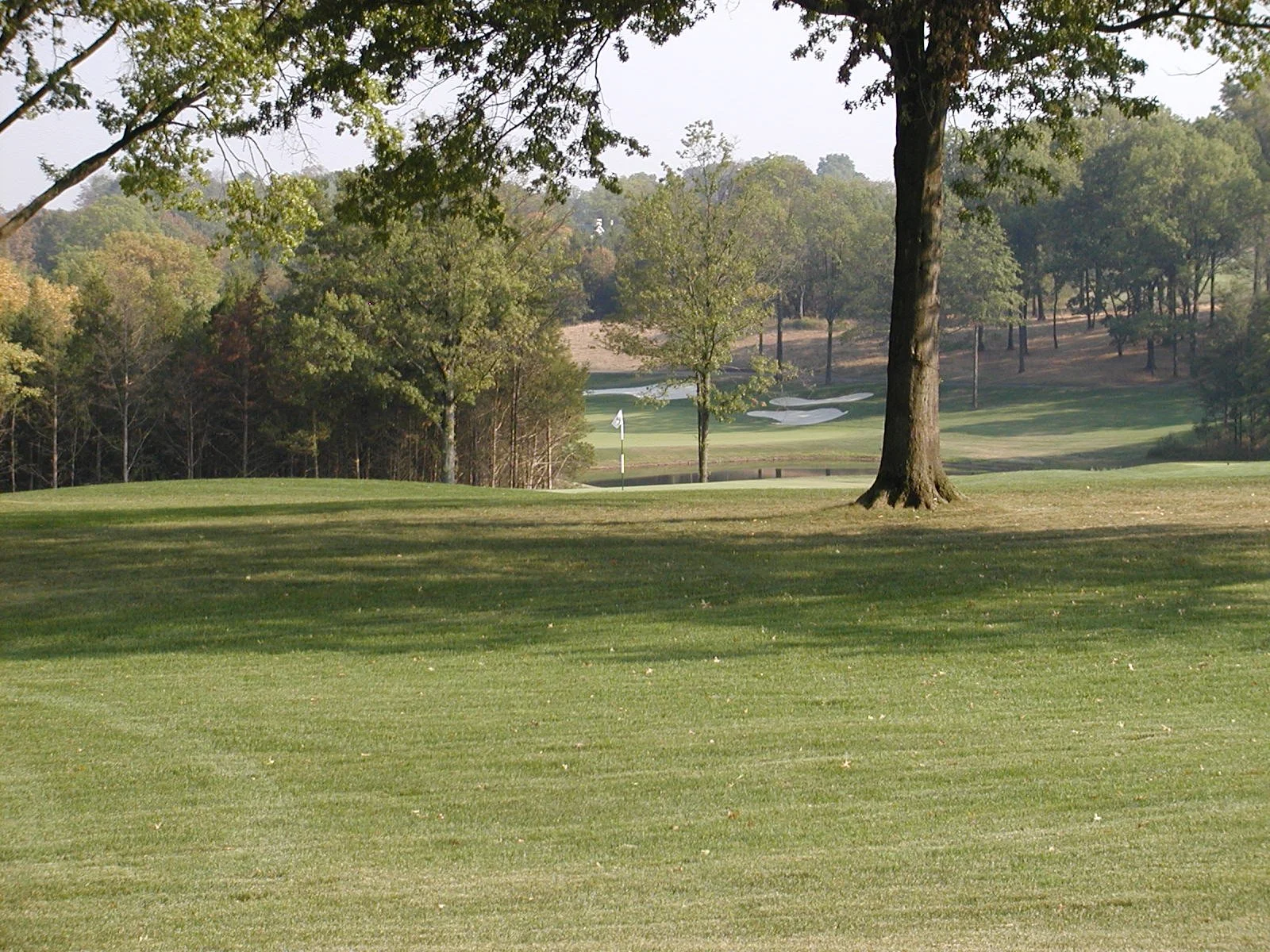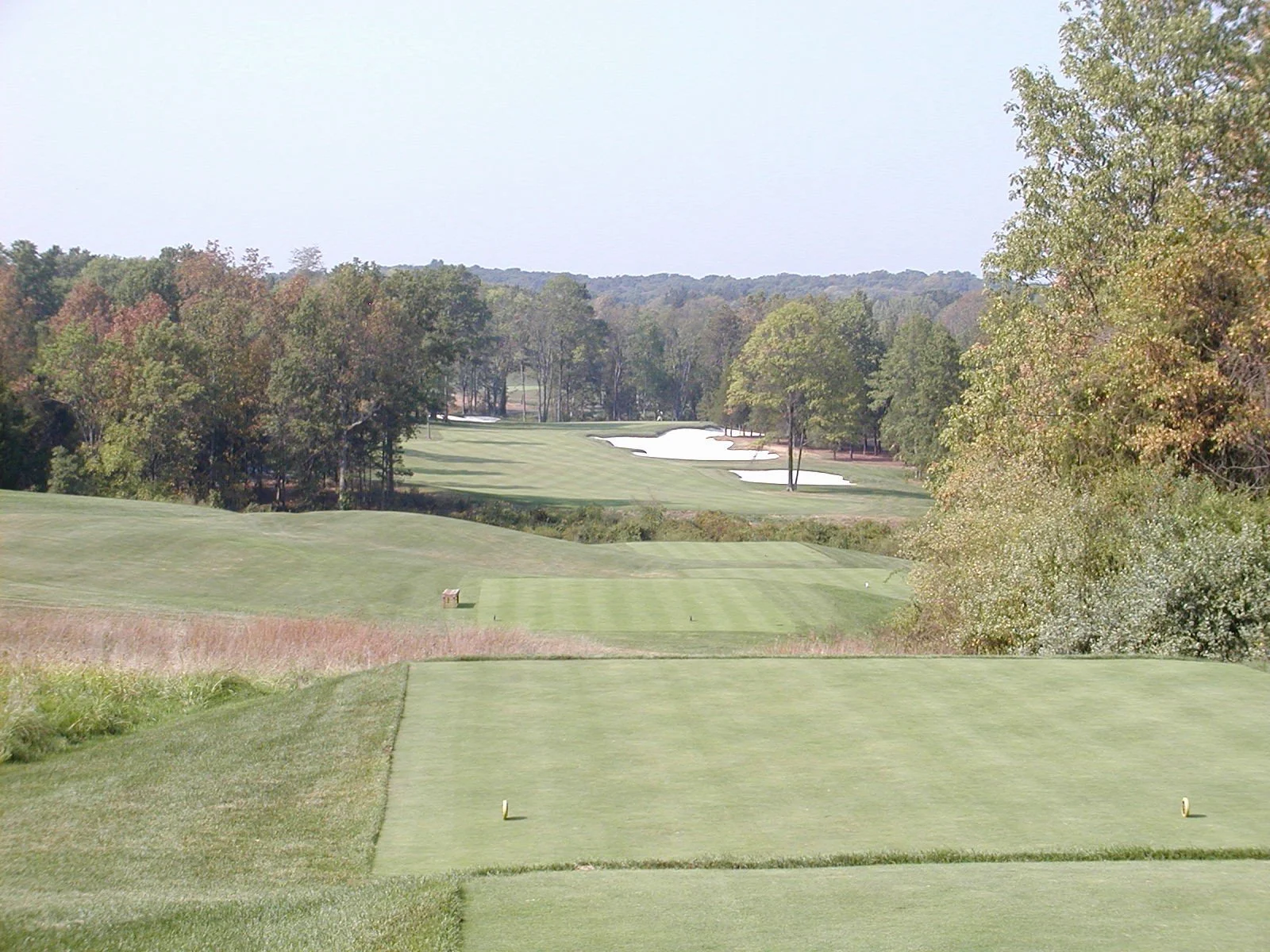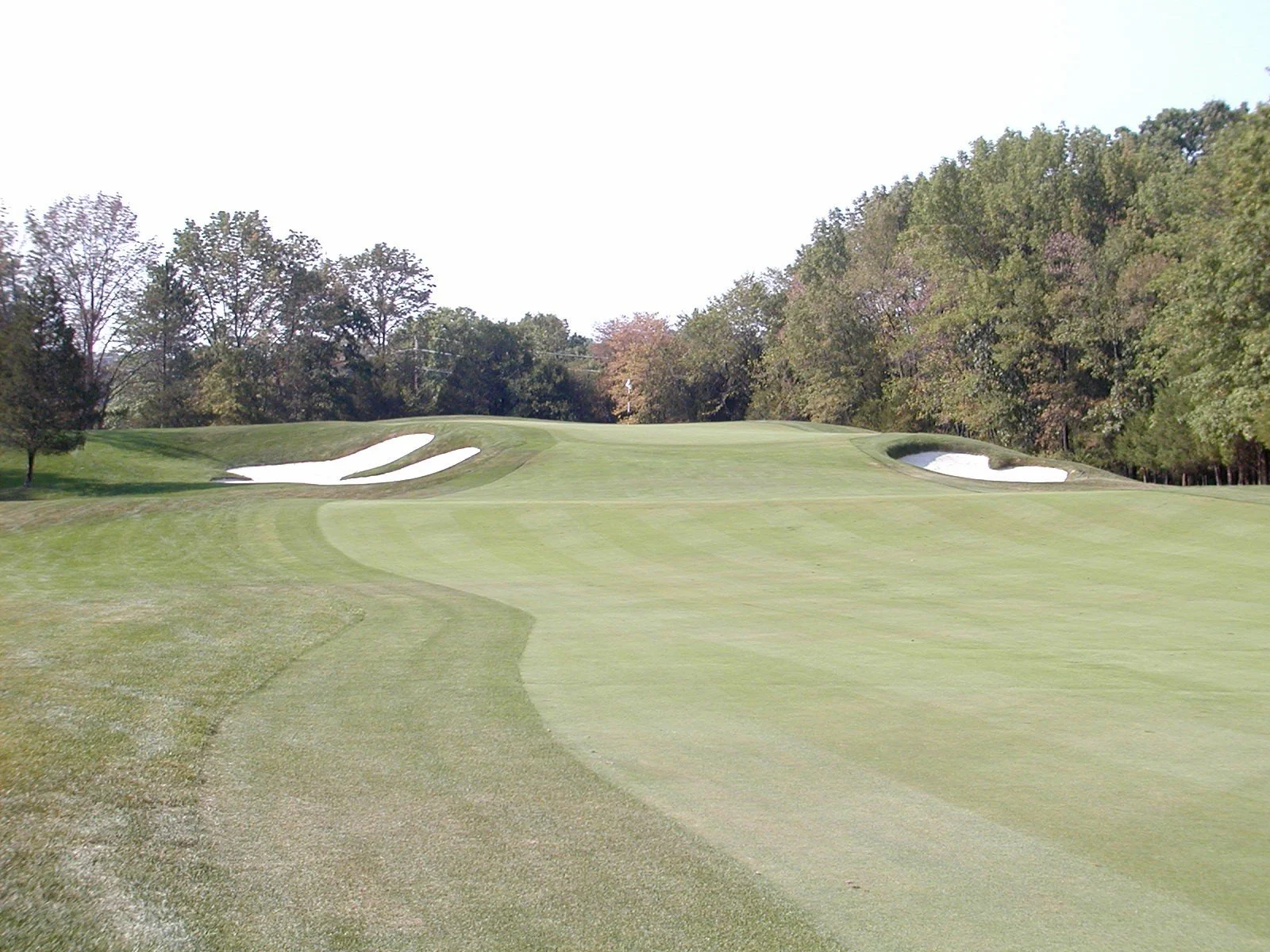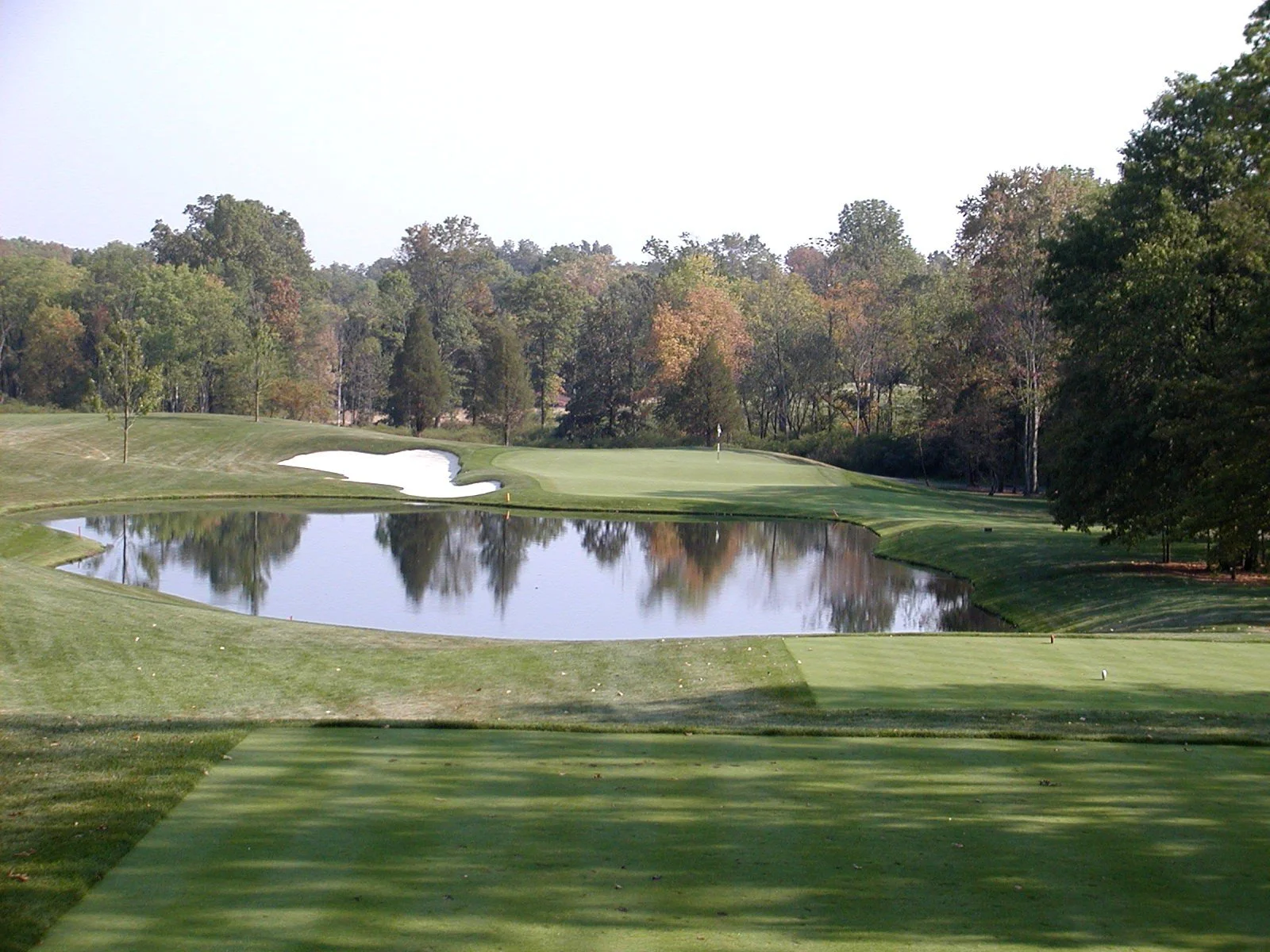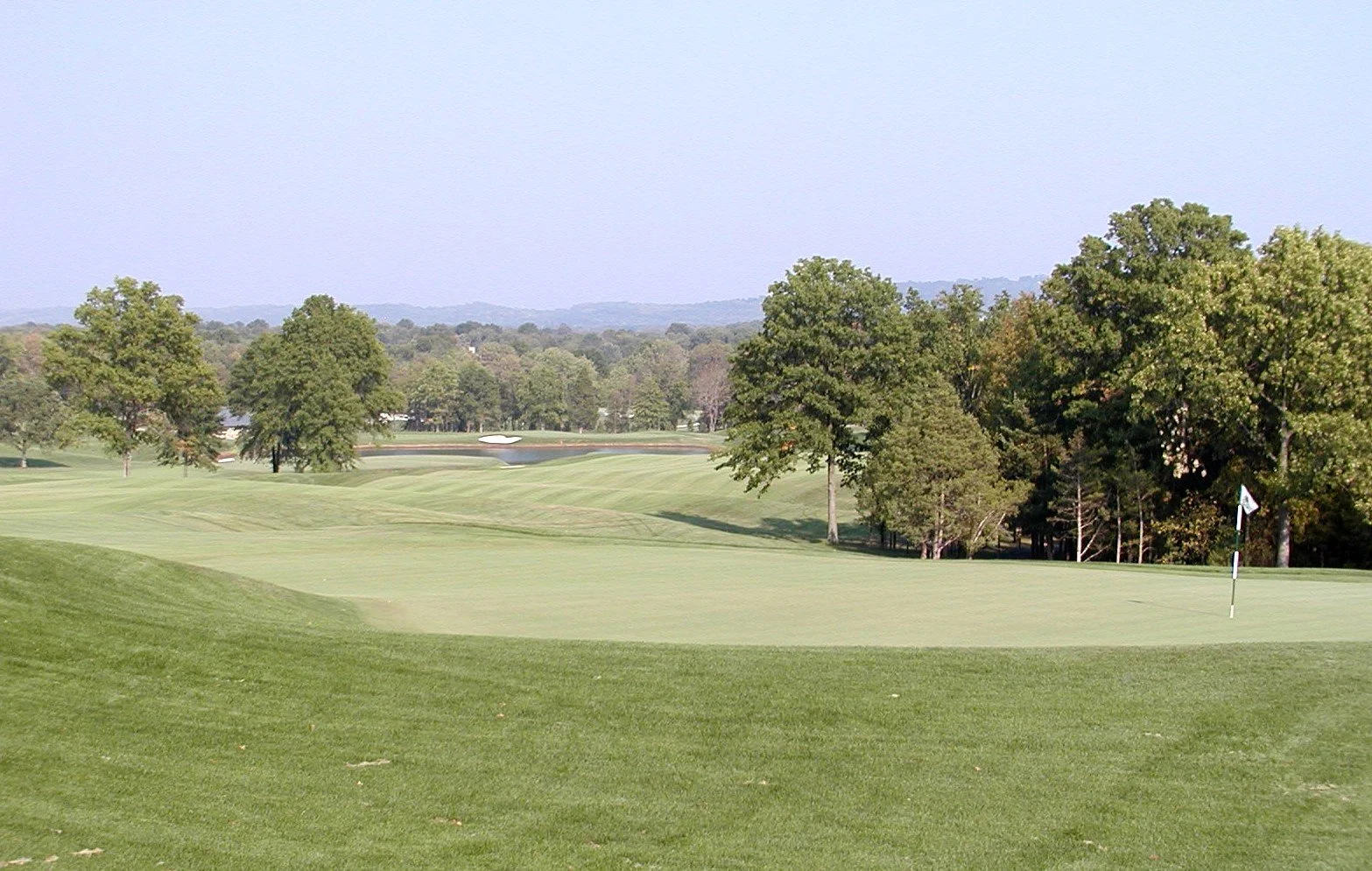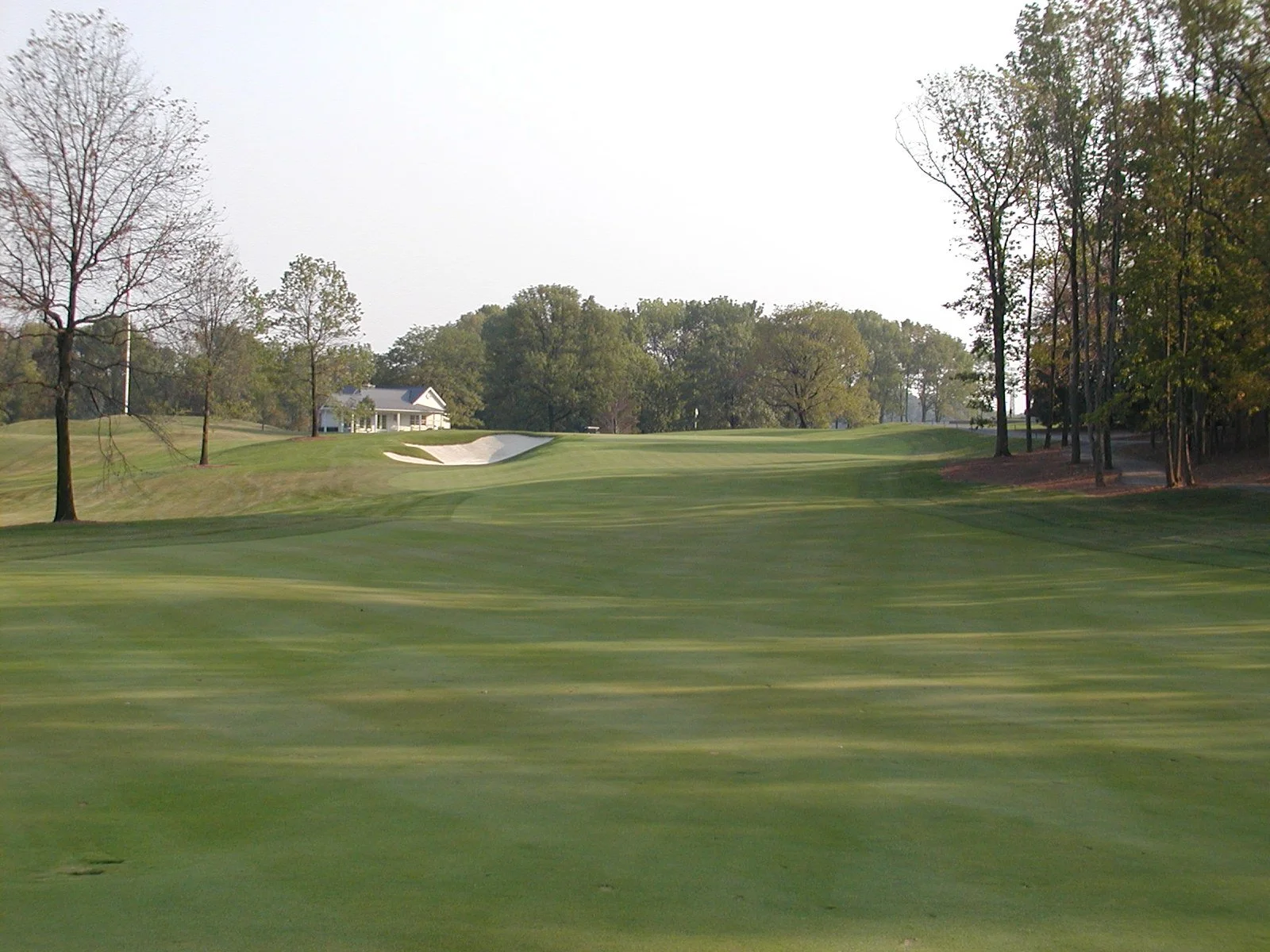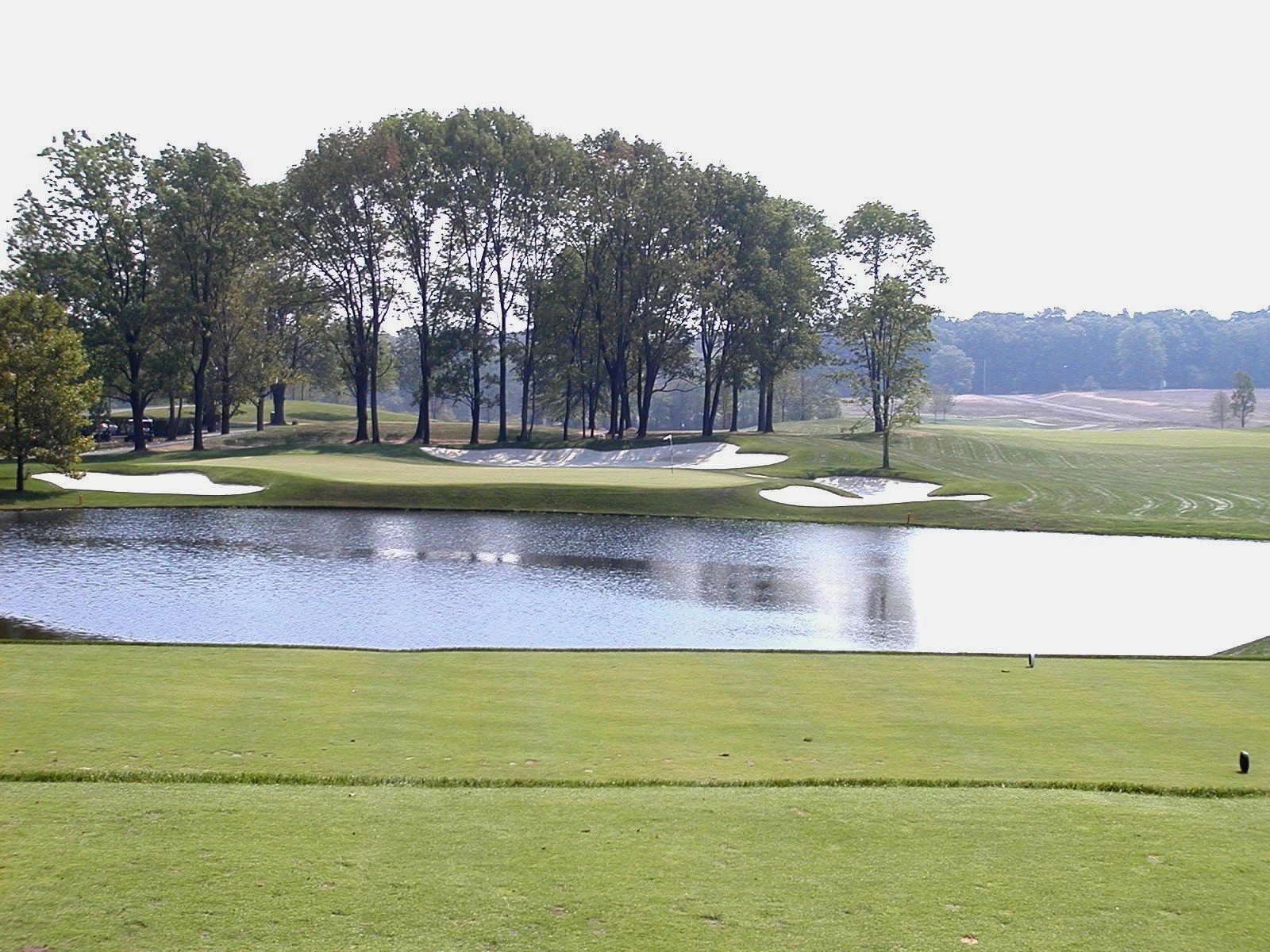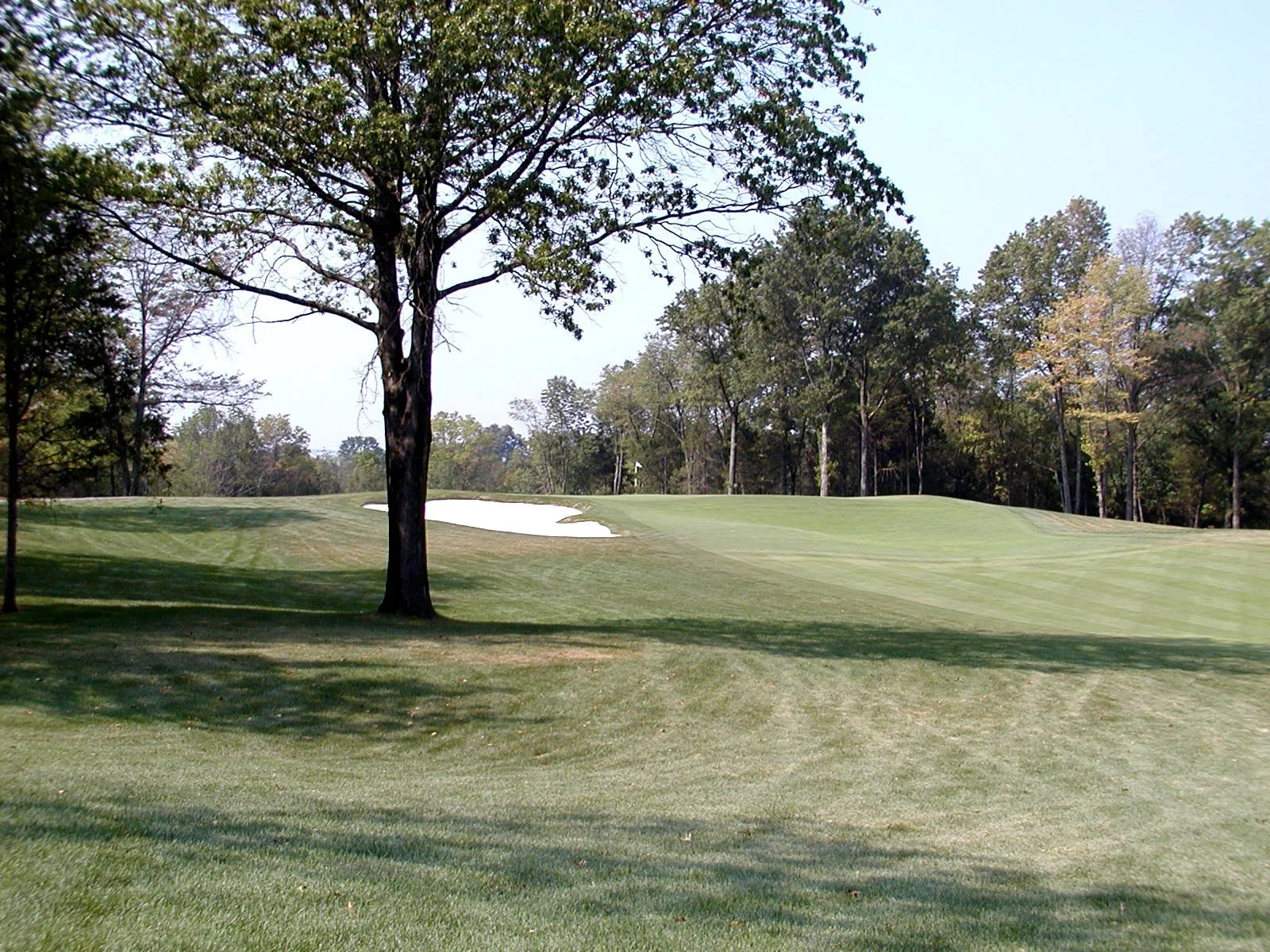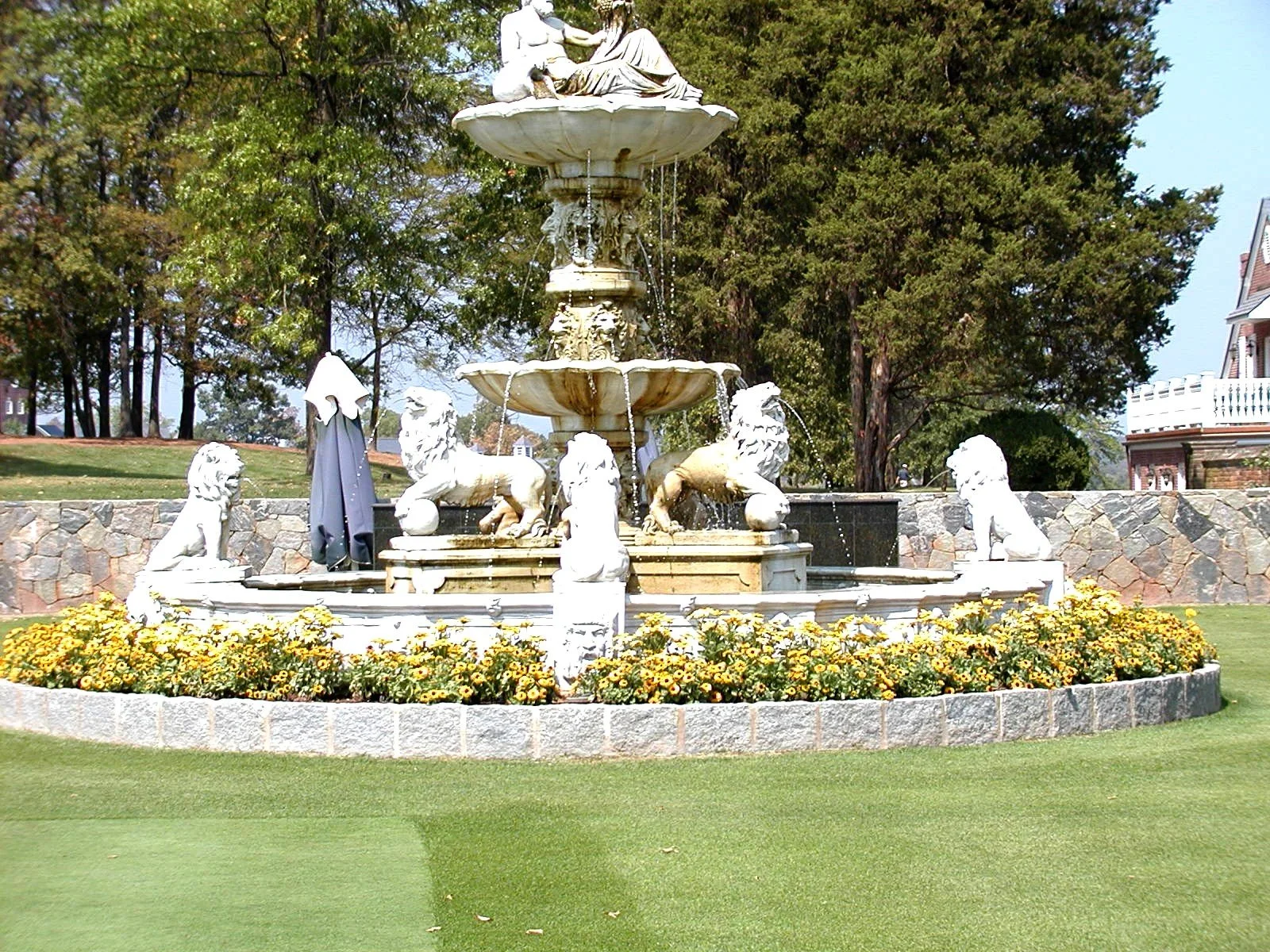TRUMP NATIONAL GC (OLD COURSE)
Course Architect: Tom Fazio
Year Opened: 2004
Location: Bedminster, New Jersey
Slope: 147. Rating: 77.3
Par: 72
Yardage: 7,560
Hole-by-Hole: 1 - Par 5 567 Yds 10 - Par 3 189 Yds
2 - Par 4 436 Yds 11 - Par 4 332 Yds
3 - Par 4 460 Yds 12 - Par 5 610 Yds
4 - Par 3 206 Yds 13 - Par 4 416 Yds
5 - Par 4 488 Yds 14 - Par 4 413 Yds
6 - Par 4 438 Yds 15 - Par 4 427 Yds
7 - Par 3 185 Yds 16 - Par 4 480 Yds
8 - Par 5 565 Yds 17 - Par 3 233 Yds
9 - Par 4 460 Yds 18 - Par 5 655 Yds
Par 36 3,805 Yds Par 36 3,755 Yds
Key Events Held: U.S. Junior Amateur (2009),
U.S. Girls' Junior (2009), U.S. Women’s Open (2017),
LIV Golf Invitational (2022-23).
Awards Won: Ranked #48 Top 100 golf courses in U.S. by Golf Magazine (2005),
Ranked #87 Top 100 golf courses in World by Golf Magazine (2005),
#45 Golf Magazine - Top-50 Greatest Courses last 50 years (2009).
Website: trumpnational.com
HISTORY: 525 acres of pristine property in the heart of New Jersey is generally not available to just anyone and when Donald Trump viewed the land, he knew it was something special and it had to be his. Quite the golfer himself, Trump opened his pockets, sparing no expense. He started off with one of the greatest architects of our time, Tom Fazio. With no less than 14 courses ranked in the top-100 in the United States, including three of the top-25, Fazio set off to create a world class golf club.
This outstanding piece of land dates back to the 1600's. The Duyckinck family, a Dutch farming family, lived on the Lamington Farm property through the early 1900's, living in the "Old Dutch House" which is located adjacent to the practice facility. The family grew apples, had an apple press to make cider, and raised sheep. Legend has it that the land was haunted. John Duyckinck, an
alleged British sympathizer was confined to live within the boundaries of the property after being jailed and exiled by George Washington in 1779. It is still unclear if Duyckinck was a Revolutionary War hero, or a British spy, but past residents claim to have heard the sounds of riding boots echoing in the stairwells.
The property was then purchased by the Morgan Cowperthwaite family in 1917. Heralded designer Mott B. Schmidt of New York City was commissioned by John K. Cowperthwaite, Morgan's son, and his wife Victoria to build the residence. Schmidt was a master architect who constructed the Susan B. Wagner wing of Gracie Mansion, Sutton Place and homes for the Vanderbilts and Rockefellers. During this time, the property flourished, as fox hunting, a diversion of society's elite, was often held in the fall, while weddings and balls also graced the land. Cattle was raised on the estate and the Lamington beef were some of the finest in the area.
The Cowperthwaite family maintained the land until automobile manufacturer John Z. DeLorean took over in 1981. Yes, that's the same DeLorean, who's car along with actor Michael J. Fox starred in the movie "Back to the Future." In January of 2000, the land was sold in bankruptcy court to Lamington Farm Club LLC, with National Fairways as a minority partner. Fazio was brought in and began construction in late 2000 and early 2001. Falling into bankruptcy of its own in 2002, National Fairways had to sell, with three holes shaped, four other holes under construction and the course fully routed. It was then, that "The Donald" acquired this magnificent tract of land and fell in love with its buildings and grounds, committing to create a course and club for the ages. Trump started by restoring the Georgian Manor house, which now serves as the clubhouse at Trump National.
Fazio and his design team were given carte blanche to create history, which is exactly what they did. "The property is sensational and the land was tremendous before we ever started," commented Fazio. In just two years, Trump National, Bedminster was rated by Golf Magazine as one of the top-100 courses in the World. That's high praise for a course that Fazio calls, "as good as it gets."
Three USGA events have been staged at Trump National, the 2009 U.S. Junior and Girls Junior Amateurs and the 2017 U.S. Women’s Open.
When the 2009 U.S. Junior Amateur Championship came to Bedminster, the field included plenty of current PGA Tour players, such as Jordan Spieth, Denny McCarthy, Wyndham Clark, Emiliano Grillo, Talor Gooch, and Patrick Cantlay. When it was all said and done, Spieth, who was the number one seed after the stroke-play portion, posted a 4 and 3 win over Jay Hwang for the title.
The Girls’ Junior Amateur Championship was also held at Bedminster in 2009, as Amy Anderson defeated Kimberly Kim, 6 and 5. The field included several LPGA stars, such as Jenny Shin, Ariya Jutanugarn, Jess Korda and Hannah Suh. Anderson was the low medalist.
Sung Hyun Park carded back-to-back rounds of 67 over the weekend to capture the 2017 U.S. Women’s Open. Seven shots after the first two days, Park made 12 birdies and just two bogeys in the final two rounds, as she defeated 19 of the top-20 players in the world competing that week. Park led the field in birdies for the week with 18 and was second in driving distance.
Shanshan Feng, who led after three rounds, struggled to a final round of 75 to tie for fifth. Amateur Hye Jin Choi finished alone in second, two shots back while Mi Jung Hur and So Yeon Ryu tied for third, four strokes behind. Feng became the seventh player to lead after three rounds that did not win. Helen Alfredsson was the last to do so in 1993.
REVIEW: Most courses open up with a relatively simple first hole, allowing for a little warm-up. Not Trump National. The opener is a rugged par five, the third handicap hole, stretching 567 yards from the black markers. Ninety-three yards of sand guards the left side of the landing area off the slightly-elevated tee, while trees flank the right. Two choices remain for your second shot. Number one, lay-up around the 100-yard mark to the green, thus avoiding the tight fairway and bunkers on both sides of the fairway. Second option, take three-metal and go for the green. Most likely you'll be short, but the green is wide open, which will leave a short pitch. The putting surface is
devoid of sand and quite large at 42 yards long, making accurate club selection crucial. Part of what makes this course so special are the outstanding vistas on each and every hole, especially number one.
The second is a fairly straight-forward par four. The key here is the tee shot, which must carry 240 yards from the elevated back buttons over a stream. Favor the right side despite the sand, as trees guard the left. The green bends slightly to the right and is flanked by 120-yard bunker that begins from 96 yards out. The putting surface, one of the longest on the course (48 yards in length), slopes from back to front and is quite slick.
The next hole lies across the road of the main driveway that leads to the clubhouse. This dogleg left par four at first look, seems fairly easy. Not so fast. A preserved wetland must be crossed from the tee to an uphill fairway that slopes away from the player on the right side. The rough is thick and the bunkering on the left is well below the fairway. Your approach to the elevated green is made even more difficult by the slope of the putting surface and the deep traps left and short-right. Making par on this hole could be harder than getting to play the course.
The fourth consecutive hole to feature a 40-yard-plus green, the par-three fourth is a gem, stretching 226 yards. From an elevated tee box, a long iron or fairway metal is needed to reach the putting surface, which is fronted by a small lake. Sand protects the left side, but the real difficulty is the green which features plenty of slope and contours.
One of the finest holes on the course, the fifth is a monster of a par four, stretching 488 yards uphill from tee to green. Not only is length a must, but accuracy is key. Thick rough covers both sides of the fairway and if that wasn't enough, a pair of traps down the right side landing area are next to impossible to get out of. Your second shot, from the rolling fairway, will require and extra club or two, just to sniff the putting surface. The green, tucked to the left, has two deep bunkers on the left side and one, short-right. A back-left pin is the most difficult on this gem of a hole.
The sixth is one of the many signature holes at Trump National. Just 438 yards from the back tees, this downhill par four plays much shorter than its yardage indicates, and features a peninsula green. The strength of the hole lies in its strategy. Driver can be used off the tee, however, that will bring sand and possible water into play. If successful, just a short, downhill 100-yard pitch will remain. The other choice, is fairway metal or long iron, which will set up a short iron into one of the longest greens on the course (49 yards). Although water is taken out of play with this option, sand traps down the right side and thick rough left join the fray. If you thought getting there was difficult, the putting surface features plenty of slope and with shaved edges towards the water, well, you do the math. Making a big number here is very possible.
If there is a breather on the front nine, it's the par-three seventh. But, let's not be too hasty. Although just 185 yards, the hole plays over water to a very shallow green that is precariously close to the edge of the lake. One trap fronts the green, however when the wind is up and the pin is back-right, the term, "bailout left," comes to mind.
The number one handicap hole on the course, the eighth is one bear of a par five. To begin with, it's 565 yards, uphill and a dogleg left. Two large traps occupy 75 yards of space on the left side of the landing area off the tee, while trees guard the right. Here is where it gets tricky. Your second shot is either a simple layup short of the creek and wetlands leaving an uphill, 150-yard shot or hit a fairway metal or rescue club over the hazard for a shorter approach. The real danger is the large, hardwood tree that blocks the left side of the fairway and the group of trees to the right. On to the green. The putting surface, the narrowest on the course (23 yards in depth), slopes from back to front and is guarded by a 50-yard, gargantuan bunker prior to the short grass. All I can say is, I'd like another shot at this hole.
Returning to the clubhouse, the ninth hole is a stout, 460-yard, dogleg right par four. Tall trees and a 46-yard trap blanket the corner of this beauty. A strong, Jack Nicklaus-type fade off the tee would be ideal, thus setting up a mid to long iron to the longest green on the front nine. The putting surface, which sits across from the clubhouse, features a massive, deep bunker on the left side. Play towards the right side and worse-case scenario, you'll make bogey. Not a a bad score on this hole.
The back nine opens with a lovely par three, fronted by a lake and featuring a wickedly, contoured green. Although a back-left flag would be difficult, any pin up front will be extremely tough, as the putting surface falls sharply toward the water. A long iron is required to negotiate this gem, but it will be the flat stick that gets you par. The green is only 29 yards deep, but it is quite wide and sloping from left to right and back to front. Miss the green here and you're making bogey...or worse.
A chance to get one back, but with a catch. The 11th is just 332 yards from the tips, however club selection from tee to green and accuracy is key. First of all, driver is not an option off the tee, as water can be reached with a blast over 250 yards. So the sensible selection would be a fairway metal or a bold three-wood down the left side. This is risky, as two bunkers guard that side of the fairway, as it narrows towards the green. The bottom line, 230 yards off the tee will leave a short pitch to a 41-yard long green, protected on the right by a lake and left by sand. Missing right or long will be a problem, especially with a deep flag. The putting surface is exposed to the elements, so be careful, or you'll make double-bogey like I did.
Most would have you believe that the par-five 12th would be a birdie hole. At 610 yards, it's more like survival. The tee shot is slightly uphill and needs to favor the left side, as a pair of long bunkers (40 and 33 yards long) flank the right. After a successful tee ball, a proper layup is required, once again down the left, as to avoid the lake which lurks short and right of the green. The putting surface is boomerang in shape, with sand left and right. A back right flag can add 20 yards to the hole and will make this one of the most difficult holes on the course.
One of the few benign holes on the course, the 13th is relatively short by today's standards at 416 yards. Devoid of fairway sand, this par four can be had, as the landing area is quite wide. A short iron will remain to this slightly dogleg right, but beware of the "Sahara" sand trap right of the green. It starts 86 yards away and encompasses most of the putting surface. Speaking of the green, it's the longest on the course, a whopping 57 yards in length.
As wide open as the 13th is, the 14th is just the opposite. A beautiful, tree-lined dogleg left par four, this 413 yarder requires a 200-yard carry just to reach the fairway and another 40 yards to get in sight of the elevated green. Grand oak trees cover both sides of the fairway, one of the prettiest settings on the course. An extra club is needed to gain entrance to the putting surface, which is just 26 yards in depth. The lone bunker on the hole is short and left of the green. Any ball on the front edge or shy of the green, will roll down back into the fairway, leaving an awkward pitch back up the hill.
The 15th starts one of the finest stretches of holes in golf. A sensational dogleg right par four, the 15th is an uphill gem that requires a 220-yard carry over a ravine to a fairway flanked by trees left and right. The uphill, rolling fairway features one trap 20 yards in length in the landing zone on
the right and another 45 yards up the fairway, for those of us who struggle off the tee and need to layup. The shallow, two-tiered putting surface is quite slick from back to front and features a huge trap, front and left.
From the highest point on the property, the view on the 16th tee is breathtaking, as you take in holes five and six to the left and what lies ahead. This massive, downhill dogleg left par four stretches 480 yards from the tips. Although elevated, the tee shot is daunting, as it requires a 255-
yard carry over a lake to a generous fairway, protected by three troublesome bunkers right and a tall oak left. Even with a properly placed tee shot, a long iron will remain, as the hole swings harshly to the left. The putting surface, although not that deep, falls off sharply on the edges and is guarded in front by a solo trap. A front-left flag could be the hardest to get at, as the green is quite tight due to slope.
How can a 233-yard par three be the easiest on the course? That's what the scorecard says, but the 17th is far from simple. The carry alone over the wetlands to the green from the tips is a modest 210 yards. Two tall trees, one on each side of the green, make for a imposing target. A pair of winding streams protect the putting surface, front and back, not to mention a deep trap, just short and left of the green. The short grass is 46 yards in depth and slopes sharply to the front. By the way, the view of the historic barn behind the green is awesome.
With the 17th behind you, now all you have to do is conquer the 655-yard 18th. This is one of those holes where you should have looked at the scorecard before starting and decided not to play the back tees. If you can imagine, 100 yards separates the gold and black buttons. The fairway traps are out of play from the back tees, as it takes a 343-yard wallop to reach one of the seven fairway traps. The key off the tee is favoring the right side, as the barn and silo jut out down the left side of this dogleg. After success off the tee, a fairway metal must negotiate long bunkers down both sides of the fairway, as you climb uphill to the green. Let's not forget that the landing area narrows as you near the putting surface. The difficulty will be with your third shot, judging the distance to the pin. The green is a 56 yards long and has a ridge in the center running from front to back. A flag in the back-right quadrant will bring the two greenside traps into play and make this one bear of a closing hole.
FINAL WORD: A course like this comes along just once in a decade. Trump National Bedminster has it all.
Let's begin with the amenities. There will be 11 cottages built on the property, located a short distance from the clubhouse in a separate "village", that will be available to members and their guests.
How about an 25-yard long swimming pool, tennis courts, spa, trap shooting range and sport clays course, riding trails and a heliport. Located adjacent to the clubhouse and across from the pro shop, the men's locker area is situated in a two-story carriage house, complete with all the comforts of home.
The clubhouse was designed by noted architect Mott B. Schmidt, who constructed the brick Georgian clubhouse in 1939.
Now let's talk golf. First of all, the practice facility. 16 acres of land, including a three-tiered driving range, short game facility with two practice greens allowing shots ranging from 20 to 120 yards, six additional practice greens in the chipping and putting area and one private lesson tee.
The course, well in a word, superb. The Bedminster layout is outstanding in all aspects and it's just two years old. Five sets of tees, ranging from 5,100 to 7,560 yards, so the course is for all players, not just the single-digit golfer.
With his name on the marquee, you have to believe that Mr. Trump would not skimp on details. He certainly has not, with impeccable grounds, great course conditioning and an fine-tuned staff, Trump National is what golf in America is all about and what it will be in the future. Big, bold and beautiful. Elevated tees, rolling, tree-lined fairways, seven water hazards, forced carries, chipping areas and large contoured greens. There's no question that this course will someday host a major event. "This course was built with tournaments in mind," said Trump. "Besides offering a great challenge for the best players in the world, we've created great spaces for gallery, ample
parking and ease of access."
Not the easiest of tickets, as Trump National Bedminster is by invitation only. But what the heck, if you got it, spend it. Spectacular countryside, phenomenal golf and a great ambiance. Can you imagine what this venue will be like in the coming years? Like a fine wine, it will only get better with age.

